#Oleander the Synthesis
Explore tagged Tumblr posts
Text
Since the @sonic-au-collision reblogged my Render art from yesterday, I thought it would be fun to do a little post explaining what With Great Power Comes is to anyone interested!
With Great Power Comes AU is a Sonic Prime AU and it asks the question of what happened in the Shatterspaces after Sonic and Shadow went home? And where were the variants of Sonic and Shadow this whole time?
The AU is split up into three main parts for the different Shatterspaces. I have plans for a fourth part, but it's not really developed yet.
Part 1: A Spark Soaring Down Through the Pouring Rain - the New Yolk story. This one follows Nine, who didn't stay behind in the Grim and instead went back to the city to help the Resistance drive off the Chaos Council for good. He very quickly discovers Momentum, Sonic's counterpart here, who has been a mobian slave since he was four years old. Nine vows to not only set him free, but help rehabilitate him afterwards. In a sense, Nine is trying to repay all the ways Sonic helped him. Along the way, Nine meets Render, Shadow’s counterpart and a computer program that the Council is using as their new enforcer. There's a whole mystery going on with him, but I won't spoil it. :D This part is the most developed right now, currently sitting at 8 chapters. Go check it out!
Part 2: We Disappoint, We Disappear, We Die But We Don't - the Bosscage Maze story. This one follows Thorn as it's revealed that she knew Lark, Sonic’s counterpart here, before the events of the show, but they had falling out and she hasn't seen him since. Miraculously, Lark shows back up one day, but he collapses on the spot. It becomes clear quickly that someone did something to Lark that caused him to pass out, but who? Thorn, Lark, and the Scavengers need to figure that out before it's too late. (The Shadow variant, Oleander, hasn't shown up yet, but he's cool. He's half plant!) This part is currently sitting at only 2 chapters, but I'll be focusing on it more once part 1 is finished. Also, if you like Sonamy, this is the story for you, because Thorn and Lark are a couple and they are adorable!
Part 3: The Difficult Balance Between A Blessing And A Curse - the No Place story. This one sadly isn't posted at all yet, as I've had to rework it a couple of times, but here's the basics. The crew of the Kraken (now with added Rusty Rose!) come across Splash, Sonic’s counterpart here, and invite him to join their crew. Splash as it turns out, is the adopted son of Oceana (the ocean goddess who essentially IS the ocean) and as such has some really cool water powers. But everything goes sideways when Torrent, Shadow’s counterpart, shows up. He’s got water powers too, along with a grudge against all life. If Splash can't figure out how to talk him out of his revenge quest, all of No Place is doomed.
If anyone would like to know more, feel free to send me an ask! My inbox is always open.
#Sky Queen#sonic the hedgehog#sonic au#sonic prime#sonic prime au#With Great Power Comes AU#nine the fox#tails nine#Momentum the Hedgehog#Render the Enforcer#Neon the Holo-Hog#Thorn Rose#Lark the Hedgehog#Oleander the Synthesis#Splash the Hedgehog Son of the Ocean#Torrent the Retribution#Tide the Water-Speaker#lore dump
25 notes
·
View notes
Text
Poison list (2)
Hello, it's me again! After some feedback on my previous potion list post, I decided to research a little more about potions and come up with this post. I hope everyone will like it!
1. Poison Ivy
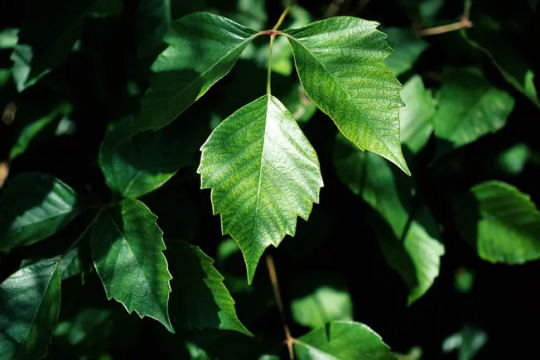
I think anyone who has watched Batman will know the female supervillain Poison Ivy. I thought it was a name she came up with until I found the Poison Ivy plant online, lol.
Eastern poison ivy is typically a hairy, ropelike vine with three shiny green leaves budding from one small stem. The leaves may be red in the fall.
Western poison ivy is typically a low shrub with three leaves. In the East, Midwest, and South, it grows as a vine.
It may have yellow or green flowers and white to green-yellow or amber berries.
It has an oily sap in its leaves called urushiol. This causes an allergic reaction that can make your skin red, swollen, and itchy.
2. Poison Oak
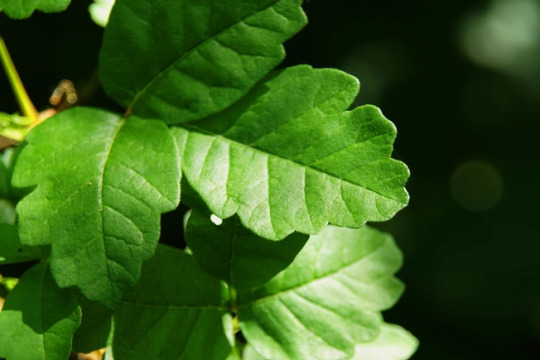
It is typically, a shrub with leaves of three, like poison ivy. The sun-facing side of the leaf has tiny hairs on it and is a darker shade of green than the ground-facing side.
Pacific poison oak may be vine-like.
Though it grows all over the country, it’s more common in the West.
It could be hours or days before your skin reacts to the plant sap (urushiol). And your rash may eventually turn bumpy and form blisters that ooze.
3. White Snakeroot
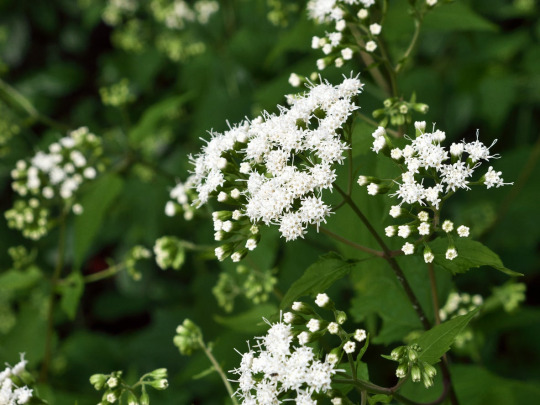
A North American herb with flat-topped clusters of small white flowers and contains a toxic alcohol known as trematol.
Generally found in woods and along streams. It is not often found on open prairies because it does not do well in full sunlight. The plant will grow 1 to 3 feet in height and will have thin smooth leaves with toothed margins.
The poisonous effects in livestock usually result from direct consumption of the white snakeroot plants. In humans, poisoning can be caused by consumption of dairy products from cows that have eaten white snakeroot.
4. Rosary Pea
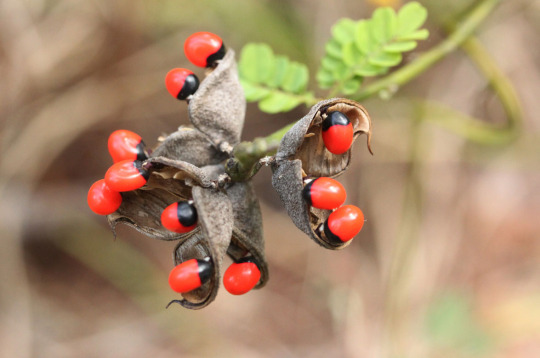
Also called jequirity beans, these piously-named seeds contain abrin, an extremely deadly ribosome-inhibiting protein.
Rosary peas are native to tropical areas and are often used in jewelry and prayer rosaries. While the seeds are not poisonous if intact, seeds that are scratched, broken, or chewed can be lethal.
It only takes 3 micrograms of abrin to kill an adult, less than the amount of poison in one seed. It is said that numerous jewelry makers have been made ill or died after accidentally pricking their fingers while working with the seeds.
Abrin in rosary pea prevents protein synthesis within cells and can cause organ failure within four days.
5. Foxglove
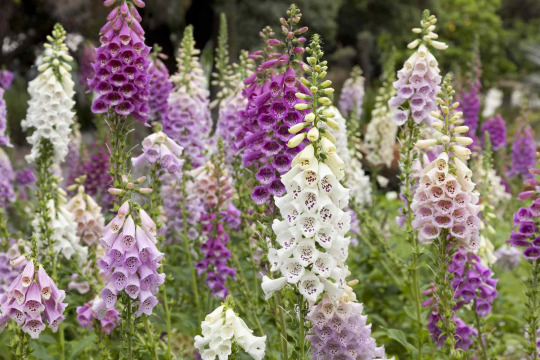
Its bell-shaped flowers are often bright purple but can be white, yellow, or pink. It blooms in the spring. It also has a fruit with lots of seeds, which kids sometimes eat.
All parts of the flower are poisonous and can slow or disrupt your heart.
In fact, digitalis (a heart medicine) is derived from this plant. When formulated into a medication with a controlled dosage, digitalis is valuable in treating heart failure. It helps a weakened heart pump harder.
People who eat any part of the plant or make tea from the leaves are, in essence, taking an unregulated dose of heart medicine. This can cause the heart rate to slow down or become irregular. Both can be dangerous and life threatening.
6. Mistletoe
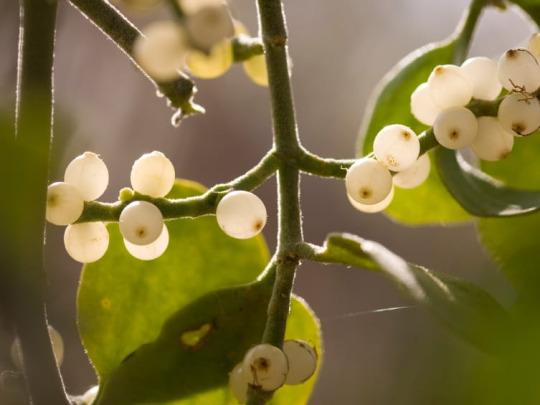
This plant lives off of other trees and shrubs, which makes it a parasite. Its stems are thick and easy to break, with lots of branches. The leaves are often thick and stay green all year. Its little yellowish flowers don’t have petals. The small, white berries have one seed and contain a sticky, poisonous pulp.
The berries can give you diarrhea and slow or stop your heart.
All parts of American mistletoe contain a toxic protein called phoratoxin, while European mistletoe contains viscotoxins, which prevent new cells from forming.
7. Oleander
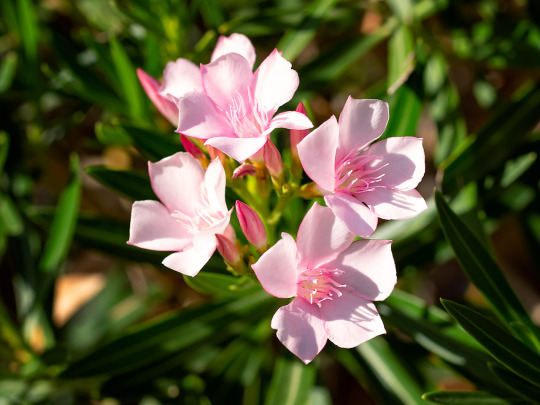
Oleander (Nerium oleander) is a common ornamental evergreen shrub.
All parts of the oleander plant are deadly and contain lethal cardiac glycosides known as oleandrin and neriine.
If eaten, oleander can cause vomiting, diarrhea, erratic pulse, seizures, coma, and death, and contact with the leaves and sap is known to be a skin irritant to some people.
The plant is very bitter.
That's all!
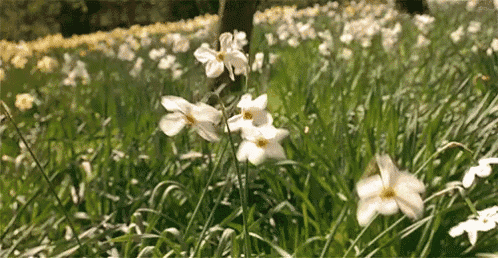
#writer things#writers#writersociety#writerscommunity#writers on tumblr#writblr#on writing#creative writing#writing#writeblr#world#writer#write#writers and poets#writings#writing stuff#novel writing#writing prompt#writing community#writing inspiration#writing ideas#writing advice#writer community#writing a book#poison ivy#poison#write it#write for us#write that down#write every day
256 notes
·
View notes
Text
6 Most Poisonous Plants in the World
Disclaimer: deadly plant references are for writing purposes only. I know it’s tempting, but murder is illegal.
6. Water Hemlock (cicuta maculata) - Water hemlock is a large wildflower that closely resembles Queen Anne’s Lace (Tall with wide clusters of small, delicate white flowers). The plant contains cicutoxin, a potentially fatal toxin. The concentration of poison is highest in the roots, which resemble wild parsnips or celery. Symptoms of hemlock poisoning are convulsions, abdominal cramps, nausea, vomiting, trembling, slow/weak pulse, trouble moving, coma, and eventually death. Those who survive usually have lasting effects such as amnesia or lasting tremors
5. Deadly Nightshade (Atropa Belladonna) - Characterized by dull green leaves and shiny, sweet black berries, Nightshade is native to Eurasian woodlands. This plant contains the toxins scopolamine and atropine, which cause paralysis in involuntary muscles of the body, including the heart. Even slight contact with the leaves can cause a rash on the skin, though it is not fatal. Symptoms include dry mouth, confusion, incoherent speech, vomiting, hallucinations, and inability to recognize loved ones.
4. White Snakeroot (Ageratina altissima) - North American herb, similar in appearance to hemlock and Queen Anne’s lace. The main toxin in these plants is an alcohol called trematol. Poisoning can occur both by direct ingestion or by drinking the milk of/eating a cow who has also ingested this plant. Symptoms are loss of appetite, unusual blood acidity, nausea, abdominal discomfort, weakness, and reddened tongue.
3. Rosary Pea (Abrus precatorius) - Rosary peas, also known as jequirity beans, are native to tropical areas. Somewhat ironically, their bright-red seeds are often used in both jewelry and rosaries. The seeds are not poisonous if they are consumed whole, damaged seeds will be fatal. It only takes 3 micrograms of the toxin, abrin, to kill an adult. This is less than the amount of toxin in a single seed. Similarly to ricin, abrin stops protein synthesis inside cells, and has similar symptoms. Death by organ failure can occur within four days.
2. Oleander ( Nerium oleander) - oleander, known for its beautiful flowers, is commonly grown as an ornamental plant. Unfortunately, all parts of this plant are deadly, containing cardiac glycosides called oleandrin and neriine. Symptoms of oleander poisoning are vomiting, diarrhea, erratic pulse, seizures, and coma. Contact with the leaves is known to cause irritation, similar to poison ivy.
1. Castor Bean (Ricinus communis) - A plant with wide, 8-pronged leaves, castor bean is a largely ornamental plant native to Africa. This plant is a natural source of the poison ricin.It takes about 8 seeds to kill an adult human, and only one to two for a child. Ricin stops protein synthesis within cells, which causes vomiting, diarrhea, and seizures before death.
61 notes
·
View notes
Text
@mcuntainbcrn said: His favorite types of poisons and their usage - GO! Baizhu Headcanon asks // Always accepting!


This actually caused me to research BUT!!!
His own Venom: (Based off of the Inland Taipan who’s venom can kill you in about 30-45 minutes if left untreated (It is said that a single bite of the inland taipan has enough venom to kill 100 grown men within 30 minutes if left untreated. Symptoms include: can cause neurotoxic, hemolytic, and coagulopathic reactions; paralysis or death could ensue rapidly- possibly more.), Baizhu uses his venom for plenty of poisons- and he’s used it on his enemies during the Archon war to protect himself. It’s a rather slow acting venom but it does work, he does pride himself on this fact but you don’t see him actively using it while he’s the good doctor. This is the same venom that claimed plenty of lives that asked him to end them during the Archon war.)
Castor Oil plant: (Although all parts of this plant are poisonous, its seeds are the most toxic part. Seeds contain castor oil, the mildly toxic alkaloid ricin, and the highly potent toxalbumin ricin that interferes with protein synthesis.) Another one he enjoys toying with here and there- especially since one milligram of Ricin can kill you within a few hours of ingestion. (Symptoms of intoxication include: vomiting, bloody diarrhea, acute renal failure, circulatory collapse, hemolysis, hypoglycemia and also allergy and anaphylaxis.) Baizhu sells this to low ranking fatui members like the debt collectors. Not a favorite because it’s taxing to harvest but fun to watch play out.)
Oleander: (This is, in his opinion, the fun one. (Oleander poisoning occurs when someone eats the flowers or chews the leaves or stems of the oleander plant (Nerium oleander), or its relative, the yellow oleander (Cascabela thevetia). Oleandrin and neriine are two very potent cardiac glycosides (cardenolides) found in all parts of the plant. Red flowered varieties of oleander appear to be more toxic. Oleander remains toxic when dry. A single leaf can be lethal to a child eating it, although mortality is generally very low in humans. Symptoms include: Irregular or slow heartbeat, Low blood pressure, Weakness, Blurred vision, Vision disturbances, including halos around objects, Diarrhea, Loss of appetite, Nausea and vomiting, Stomach pain, Confusion, Death, Depression, Disorientation, Dizziness, Drowsiness, Fainting, Headache, Lethargy, Hives, and Rash [NOTE: Depression, loss of appetite, and halos are most often seen in chronic overdose cases.]) This is one he mainly uses for when dealing with the Harbingers- but sometimes he can slip this horror into things his enemies ask for.)
Monkshood: (The toxins in Wolfsbane can cause a slowing of heart rate which could be fatal, and even eating a very small amount can lead to an upset stomach. Its poison can also act through contact with the skin, particularly through open wounds. Symptoms include: In poisonings, the onset of symptoms occurs within minutes to a few hours after swallowing. The severity of aconitine poisoning is related to the rapid onset of life-threatening heart rhythm changes. Other symptoms can include numbness and tingling, slow or fast heart rate, and gastrointestinal manifestations such as nausea, vomiting, abdominal pain, and diarrhea. Respiratory paralysis and heart rhythm abnormalities can lead to death.) Another favorite of his, but he rarely uses it. Just because it can effect you just through touch- when he does use this one, Baizhu is careful enough to wear gloves)
Angel’s trumpet: (Angel’s trumpet contains a large amount of belladonna alkaloids, also known as parasympatholytics. The belladonna alkaloids include atropine, hyoscyamine, and scopolamine. Scopolamine is specifically nicknamed “Devil’s Breath” due to its use by robbers in Columbia to incapacitate their victims.The roots and seeds of Angel’s trumpet contain the highest alkaloid concentrations, while each blossom contains approximately 0.3 mg of atropine and 0.65 mg of scopolamine. Symptoms include: confusion, dilated pupils, intense thirst, dry skin, flushing, fever, high or low blood pressure, fast heartbeat, difficulty breathing, hallucinations, nervousness, loss of memory, convulsions, paralysis, coma, and death.) Another one Baizhu sells to the Fatui, though he saves this for the Harbingers along with Oleander.)
#Answered;;#Please have mercy and save my soul;; {Baizhu}#I'm telling you that you'll be safe with me;; {Headcanons}#Mcuntainbcrn#Queue;;#Long post;;
9 notes
·
View notes
Note
what emo bands or songs would you recommend?
hello anon thank you so much,, before we begin this roller coaster I wanna add that my boyfriend @autitransylveon also has very good emo music taste that differs from mine, so I definitely reccomend also going and asking him,,
Literally the way I ordered these is not important, you are probably better off listening to them in order of how cool the titles sound to you, some of these don’t fit under “emo” music I feel like but they are emotional and have emo vibes to me so I put them in anyway,, also a lot of these have topics and lyrics that are very seriously upsetting because it is emo music so watch out for that!!! I hope this helped introduce you to some new songs and bands and stuff!!!
Faces - Scary Kids Scaring Kids
Icicles - The Scary Jokes
Feelin’ So Matryoshka - The Scary Jokes
Felt Like I Had Died - Left At London
I Don’t Trust U Anymore - Left At London
Personal Space Invader - AJJ
Heartilation - AJJ
Kokopelli Face Tattoo - AJJ
Toxicity - System Of A Down
Chop Suey - System Of A Down
Animal I Have Become - Three Days Grace
Pain - Three Days Grace
Get Out Alive - Three Days Grace
Boulevard Of Broken Dreams - Green Day
Basket Case - Green Day
My Lovenote Has Gone Flat - leathermouth
Attention Reader - Pencey Prep
Brother - Gerard Way
Empty - Kevin Abstract
Rock Baby - Foxx Bodies
Annie - Foxx Bodies
Thrash Unreal - Against Me!
Black Me Out - Against Me!
In Too Deep - Sum 41
I Wanna Get Better - Bleachers
Yer Killin’ Me - Remo Drive
February - Beach Bunny
Torniquet - Evanescence
Bring Me To Life (Synthesis) - Evanescence
The Middle - Jimmy Eat World
Touch Up - Mother Mother
Oh Ana - Mother Mother
Ghosting - Mother Mother
Body - Mother Mother
Oleander - Mother Mother
Little Pistol - Mother Mother
Infinitesimal - Mother Mother
Dark Days - PUP
Reservoir - PUP
Sleep In The Heat - PUP
Bare Hands - PUP
Cigarette Daydreams - Cage The Elephant
Halo - Cage The Elephant
Cold Cold Cold - Cage The Elephant
Aberdeen - Cage The Elephant
Pressure - Paramore
That’s What You Get - Paramore
We Are Broken - Paramore
Careful - Paramore
Brick By Boring Brick - Paramore
Turn It Off - Paramore
All I Wanted - Paramore
Monster - Paramore
Decode - Paramore
Papercut - Linkin Park
Numb - Linkin Park
Breaking The Habit - Linkin Park
Faint - Linkin Park
Thnks Fr The Mmrs - Fall Out Boy
20 Dollar Nosebleed - Fall Out Boy
Time To Dance - Panic! At The Disco
Camisado - Panic! At The Disco
Northern Downpour - Panic! At The Disco
The Ballad Of Mona Lisa - Panic! At The Disco
London Beckoned Songs About Money Written By Machines - Panic! At The Disco
New Perspective - Panic! At The Disco
I put My Chemical Romance songs seperately, because it’s Different they’re Special to me I tried to keep this list to a minimum,, anyway emo ass MCR songs:
Vampires Will Never Hurt You
Headfirst For Halos
Demolition Lovers
I’m Not Okay (I Promise)
Thank You For The Venom
Cemetery Drive
Sleep
I Don’t Love You
This Is How I Dissapear
Famous Last Words
The Kids From Yesterday
Fake Your Death
All The Angels
Kill All Your Friends
Desert Song
Bury Me In Black
The World Is Ugly
#anonymous#answered#music#long post#i spent like 2 hours on this it was a lot of fun actually i lovd it these are some of my favorite songs....
26 notes
·
View notes
Photo
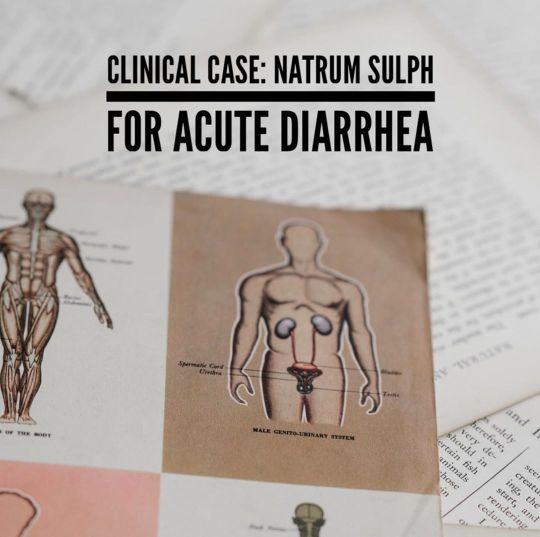
A 25 year old female was receiving treatment for dyspepsia. In the course of treatment, she felt ill from loose stool (5-6 times a day). Urging was very marked but there was no abdominal pain and no vomiting. No noticeable causation found, Symptoms are as follows: Loose stool (5-6 times a day) gushing with urging. Flatulence marked, increased flatus while passing stool. Clinical examination was unremarkable except dirty tongue with faint brownish-yellowish coating. Prescription: Natrum Sulph 200CH, tid for 3 days. After 7 days, everything was back to normal. Why did I prescribe Natrum Sulph? The most peculiar aspect of the case to me is the combination of the two symptoms: gushing diarrhoea with much flatus during passing stool. This is very characteristic of Nat-sulph, which has been verified in clinical practice many times. If we see the rubric flatus during stool in the Synthesis repertory, we will find few other remedies e.g. Aloe, Carb-v, Oleander etc. but Aloe has pain before stool which usually decreases after passing stool and strong urging after eating and drinking. Carb-v is usually indicated where there is diarrhoea after eating fat food, cabbage or history of overeating is present and the putrid discharge is very marked in Carb-v. Oleander is very well indicated when patient is having involuntary stool while passing flatus (also present in Aloe Socotrina). Gambogia is another drug having the similar symptom of gushing diarrhoea but again in Gambogia pain is marked. Dr. Vivekananda Chakravorty is a practising Homeopath from India, dealing with various types of acute and chronic diseases. Email: [email protected] . @homeopathy_school_in_toronto . #homeopathy #homeopathic #homeopati #homeopath #homeopathicremedy #homeopathie #homeopathie #homeopathicmedicine #homeopathicremedies #homeopathyworks #homeopathyheals #homeopathyrocks #homeopathyforall #naturopathicmedicine #natureheals #naturehealing #patientsfirst #naturalremedies #healthandwellness #wellnessblogger #healthyliving #healthyoptions #alternativemedicine #naturaltherapies #natureheals #homeopathyworks #homeopathyworksforme #homeopathyheals #ilovehomeopathy #healthandwellbeing (at Toronto , Ontario , Canada , North America , Earth , Galaxy , Etc :P) https://www.instagram.com/p/B5aHt5FF7rh/?igshid=12t1ujx87jf6n
#homeopathy#homeopathic#homeopati#homeopath#homeopathicremedy#homeopathie#homeopathicmedicine#homeopathicremedies#homeopathyworks#homeopathyheals#homeopathyrocks#homeopathyforall#naturopathicmedicine#natureheals#naturehealing#patientsfirst#naturalremedies#healthandwellness#wellnessblogger#healthyliving#healthyoptions#alternativemedicine#naturaltherapies#homeopathyworksforme#ilovehomeopathy#healthandwellbeing
0 notes
Link
A Visit to a Poison Garden Dr. Mercola By Dr. Mercola The 12-acre Alnwick Garden in northern England is home to fragrant rose bushes, manicured hedges, a cherry orchard and stunning water features — all things you'd expect in a traditional English garden. But behind a locked gate is a garden with a much more sinister air — a poison garden home to plants that have the ability to kill. A sign on the gate reads, "These plants can kill," and visitors may only enter with a guide, in groups of 20 or less, who are warned not to touch, sniff or venture too close to the deadly plants. Some are so dangerous they're grown in metal cages with cameras tracking them 24/7. The project was started in 2005 by Jane Percy, the Duchess of Northumberland. Centuries ago, apothecary gardens were quite common in England and were used to grow medicinal plants used for a variety of treatments. Percy was intrigued by the more macabre side of the plant world, however, explaining to Australia's News.com, "What's really interesting is to know how a plant kills you, and how the patient dies, and what you feel like before you die … Most plants that kill are quite interesting."1 Plants That Can Kill in the Poison Garden More than 100 deadly plant species can be found in Alnwick's poison garden. The poisonous properties are often used by the plants as a form of protection. Many of them may be harnessed for good (for instance in the treatment of cancer or nerve pain), with the difference between benefit and harm coming in the dose. For instance, the Helleborus genus of flowering perennials grown in the poison garden were once used to help children get rid of intestinal worms, but if too much was given, it were deadly.2 Other poisonous plants in the garden range from common daffodil bulbs and laurel hedges to marijuana, cocaine, magic mushrooms and opium poppies, for which Percy obtained a special permit to grow. NPR expanded on some of the garden's highlights:3 " … [I]t doesn't take many berries from Atropa belladonna (deadly nightshade) to kill … the plant is common in England and growing happily in the Poison Garden. The duchess also warns that that merely brushing up against the bushy green Ruta graveolens (commonly called Rue) or touching the sap from Euphorbia (the Dr. Suess-like plants sometimes called spurge) can give a person a nasty rash." Another intriguing plant in the garden is datura, also known as angel's trumpets, a night-blooming perennial and member of the nightshade family. Most part of the plant contain hallucinogens that can cause delirious behavior and death.4 Percy told The Telegraph:5 "Datura is an incredible poison, but an amazing aphrodisiac, too, and you see it everywhere. In Argentina, even nowadays, some people put a bell of Datura … on a baby's pillow at night, then take it away after five minutes and the baby has gone to sleep. If it were left all night the baby would be dead in the morning. Victorian ladies used to sit around a table with a datura plant in the middle and play cards or have tea. They'd pop their cup under a bell, tap it, and pollen would fall into the cup. They would experience similar effects to that of LSD." 15 More Plants That Can Kill If you look around your backyard and possibly even your kitchen, you may find a surprising number of toxic plants, ranging from mildly poisonous to deadly. Among them:6 1. Apple Trees Apple seeds contain amygdalin, a plant compound known as a cyanogenic glycoside. When apple seeds are chewed or crushed and metabolized, the amygdalin turns into hydrogen cyanide, which is poisonous. That being said, the cyanide is produced only if the seeds are damaged (i.e., crushed or chewed), so swallowing a few seeds whole is virtually harmless. 2. Nightshade Plants The Solanaceae family of vegetables, informally known as nightshades, includes tobacco, tomatoes, peppers, eggplants and potatoes. The foliage, vines and berries of such plants are toxic and should be avoided. 3. Rosary Pea This plant goes by many names, including precatory bean, Buddhist rosary bead, love bean, lucky bean, Indian licorice, prayer bean and weather plant. Rosary peas are used as ornamental beads for jewelry around the world, but they contain toxic compounds called abrin (a relative of extremely toxic ricin) and abric acid. It's said that jewelry makers have died after from pricking a finger and handling the peas.7 Consuming even one rosary pea can be deadly to pets, but fortunately the seed's hard outer coat must be damaged (crushed or cut open) to cause harm. So in many cases ingesting the seeds may lead to only mild illness. However, if a broken pea is ingested, it can lead to severe vomiting and diarrhea (sometimes bloody), tremors, high heart rate, shock, fever and death among dogs, cats and horses. 4. Oleander Oleander, or rose bay, contains cardiac glycosides that can cause vomiting, dizziness and cardiac dysrhythmias. In Sri Lanka, yellow oleander seeds are often used as a suicide agent, with thousands of cases reported each year. About 10 percent of cases of oleander poisoning in Sri Lanka are fatal.8 Your pet may also be poisoned from access to pruned or fallen oleander branches while horses may be poisoned by consuming this ornamental plant near horse show arenas. 5. European Yew Yew contains toxic taxine in its bark, leaves and seeds, which, if consumed, can lead to sudden death from heart failure. Yew leaves and seeds are also sometimes used by people attempting to commit suicide. Keep an eye out on your dogs if you have yew in your yard; even playing with the branches or sticks from the yew tree could be potentially deadly to dogs. 6. Daffodils Also known as narcissus, daffodils contain lycorine, particularly in the bulbs. This toxic chemical can lead to nausea and vomiting followed by low blood pressure and liver damage. 7. Doll's Eye This plant, also known as white baneberry, is a member of the buttercup family. It has distinctive white berries with an eye-like black dot in the center, growing on red stalks. The berries are particularly poisonous, as they contain cardiogenic toxins. It's said that eating five or six of the berries can make you sick while consuming more can be deadly.9 8. Hemlock All parts of the hemlock plant are poisonous, but the root contains the greatest concentration of poison. Hemlock is said to have been used to execute Socrates, and there are reports of children dying after making whistles out of hollow hemlock stems.10 Ingesting the plant may lead to muscle weakness and paralysis, progressing into respiratory failure. 9. Stinging Tree Found in Australian and Indonesian forests, this stinging nettle can lead to a stinging sensation that lasts for weeks. In animals, brushing past the plant may cause a severe allergic reaction. 10. Castor Beans Castor beans contain the extremely toxic substance ricin. Consuming even one castor bean can kill a human or pet, but the plants are relatively common, even in public areas. Ricin inhibits protein synthesis, leading to convulsions and kidney failure.11 According to NPR:12 "In 1978 a member of the Bulgarian secret police used an umbrella tip to inject ricin — a powerful poison extracted from the beans of a castor plant — into the leg of a political dissident, as he walked down a London street." 11. Monkshood This plant, also known as devil's helmet and aconitum, is so deadly that a U.K. gardener died in 2014 after handling the plant.13 It was also a well-known poison in ancient times, used during battles to poison enemies' water.14 12. White Snakeroot This plant contains toxic tremetol, which is poisonous if ingested, either directly or via contaminated meat or milk. If a cow grazes on the plant, for instance, its meat and milk will become poisonous. Nancy Hanks, Abraham Lincoln's mother, reportedly died from "milk sickness" after consuming milk contaminated with white snakeroot.15 13. Larkspur Larkspur contains compounds called diterpene alkaloids that are toxic to humans, dogs, cats and horses. It's thought the toxicity of this plant varies depending on the conditions in which it's grown and becomes less toxic as it matures. If consumed, larkspur can cause neuromuscular paralysis and symptoms such as muscle tremors, stiffness, weakness, convulsions, heart failure and death from respiratory paralysis. 14. Foxglove This plant grows striking bell-shaped flowers, but all parts of the plant contain digitalis glycosides, which can affect heart function, leading to irregular heartbeat and death in humans and pets. 15. Melia Azedarach This flowering tree, also known as white cedar, is native to Australia and contains berries with neurotoxic poisons. Consuming just six berries may be enough to kill a person, but birds are not affected, so they feast on the berries regularly.16 Plant Poisonings Are Relatively Common in the US While pharmaceuticals remain a top cause of calls to poison control centers, plant exposures also have a top spot on the list. Data from the American Association of Poison Control Centers' National Poison Data System (NPDS) 2013 annual report revealed more than 46,000 plant exposures in the U.S., with more than 29,000 involving children aged 5 years or younger.17 Three deaths were also reported. To avoid poisonous plants, be very careful when selecting which plants to put in your garden or home, especially if you have young children or pets. If you're planning to forage for wild edible plants, consume only those you are sure you can correctly identify and are not poisonous. Fortunately, there are far more edible plants than poisonous ones. Wild plant enthusiast Sergei Boutenko claims there are thousands of safe, edible plants growing wild in North America, but there are only 150 listed by the American Association of Poison Control as poisonous.18 Of those 150, only about 50 are considered to be "highly poisonous" (i.e., can be fatal), and the rest are classified as "mildly poisonous," which means they may cause nausea, diarrhea, or headache, but probably will not kill you. If you see a wild plant you can't identify, the characteristics that you should regard as "red flags" for toxicity include the following. As always, if you're not sure, don't eat it. ✓ Milky or discolored sap ✓ Beans, bulbs or seeds in pods ✓ Bitter or soapy taste ✓ Spines, fine hairs or thorns ✓ Dill, carrot, parsnip or parsley-like foliage ✓ "Almond" scent in woody parts or leaves ✓ Grain heads with pink, purple or black spurs ✓ Three-leaved growth pattern
0 notes
Text
Happy 2025!! Here's all the doodles I did for New Years Eve :)

#Sky Queen#new years#sonic the hedgehog#shadow the hedgehog#rouge the bat#Shadouge#Miles “Tails” Prower#Nikolai Peterson#Oleander the Synthesis#Caderyn the Hedgehog#eclipse the darkling#Momentum the Hedgehog#Blake the Pyromaniac Porcupine#Splash the Hedgehog Son of the Ocean#sonic redesign#art#my art
23 notes
·
View notes
Text
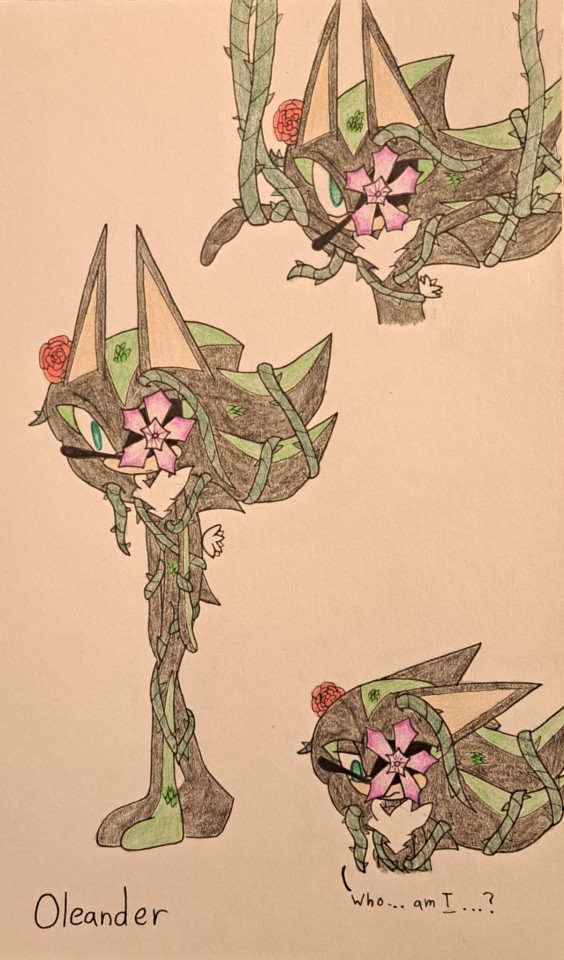
And to finish off the trio of my Shatterverse Shadows from my With Great Power Comes AU, here's Oleander in color!! I tried to make his colors kinda pale since. He is half dead. XD I'm still so in love with Ollie's design. All the flowers and vines and leaves growing out of him give me chills and I love it!!! Anyway, here's the original sketches + Ollie's lore!
#Sky Queen#Sonic the Hedgehog#Sonic Prime#Sonic AU#sonic prime au#With Great Power Comes AU#Oleander the Synthesis#Bosscage Shadow#art#my art#traditional art
15 notes
·
View notes
Text

**Evil Laugh** This! This boy is amazing! Introducing Oleander the Synthesis. He was the first Shatter-verse Shadow I drew and I love him so much!!
Oleander is an interesting case in that he's one of the only Shadows in existence that's actually a real natural hedgehog. He wasn't created by Gerald. Oleander lived in the Bosscage Maze fifty years ago, before it had completely taken over the planet. I'd tell you what his life was like . . . But he doesn't remember it at all.
One day, Gerald went out into the jungle and discovered Oleander, mortally injured and dying. He took the hedgehog back to the village and set to work saving his life. Gerald had been working on a plant based treatment to try to cure Maria’s NIDS, so he attempted to use it on Oleander as a sort of test run. It did indeed save his life, but it also resulted in the plants invading his body and becoming one with him. Gerald saw Oleander as a failure, but Maria took him in as a friend. Eventually though, she succumbed to her illness and passed away. Having no more reason to stay in the village, Oleander wandered into the Bosscage and wasn't seen again for many years.
Oleander has some control over plants, but only ones in his immediate surroundings. He can use them to attack if angered, but if you can actually get him that angry, you better run because he's about to eat you like a carnivorous plant. Mostly, Oleander uses vines to keep himself upright. He's a little limp noodle, lol.
Oleander had found that his emotions have been clouded thanks to the plants. He doesn't feel much anymore. However, he has been sensing something recently. The closer he gets to it, the more clear his emotions become. So now, he's trying to get to it. He has to get to it.
Oleander was kinda inspired by the Plant-Posessed Shadow @son1c made. Except this Shadow isn't being controlled by plants. They're a part of him.
Love this boy so much!!! 💚💚💚
EDIT: Colored version here!
#Sky Queen#Sky's art#art#traditional art#Sonic the Hedgehog#Sonic Prime#Sonic Prime AU#With Great Power Comes AU#Oleander#Oleander the Synthesis#Bosscage Shadow#Gerald Robotnik#Maria Robotnik#Shatter-verse Shadows
20 notes
·
View notes
Text
I decided to ink my Shaterverse Shadows so I can color them. Oleander is the last one to ink and he's taking absolutely forever. XD
I'm realizing that . . . I may have gone a bit overboard on the shear amount of details his design has.
#Sky Queen#Sonic the Hedgehog#Sonic Prime#Sonic AU#With Great Power Comes AU#Shadow the Hedgehog#Oleander the Synthesis#Bosscage Shadow
5 notes
·
View notes
Text
Been thinking about With Great Power Comes. I think I finally have a full plot for Lark and Oleander's story. >:)
#Sky Queen#Sonic the Hedgehog#Sonic Prime#Sonic AU#With Great Power Comes AU#Lark the Hedgehog#Oleander the Synthesis#Shatter-verse Sonics#Shatter-verse Shadows#Bosscage Sonic#Bosscage Shadow
1 note
·
View note
Text

AAAAAAAAAAAAAAAAA
I LOVE HIM I LOVE HIM-

**Evil Laugh** This! This boy is amazing! Introducing Oleander the Synthesis. He was the first Shatter-verse Shadow I drew and I love him so much!!
Oleander is an interesting case in that he's one of the only Shadows in existence that's actually a real natural hedgehog. He wasn't created by Gerald. Oleander lived in the Bosscage Maze fifty years ago, before it had completely taken over the planet. I'd tell you what his life was like . . . But he doesn't remember it at all.
One day, Gerald went out into the jungle and discovered Oleander, mortally injured and dying. He took the hedgehog back to the village and set to work saving his life. Gerald had been working on a plant based treatment to try to cure Maria’s NIDS, so he attempted to use it on Oleander as a sort of test run. It did indeed save his life, but it also resulted in the plants invading his body and becoming one with him. Gerald saw Oleander as a failure, but Maria took him in as a friend. Eventually though, she succumbed to her illness and passed away. Having no more reason to stay in the village, Oleander wandered into the Bosscage and wasn't seen again for many years.
Oleander has some control over plants, but only ones in his immediate surroundings. He can use them to attack if angered, but if you can actually get him that angry, you better run because he's about to eat you like a carnivorous plant. Mostly, Oleander uses vines to keep himself upright. He's a little limp noodle, lol.
Oleander had found that his emotions have been clouded thanks to the plants. He doesn't feel much anymore. However, he has been sensing something recently. The closer he gets to it, the more clear his emotions become. So now, he's trying to get to it. He has to get to it.
Oleander was kinda inspired by the Plant-Posessed Shadow @son1c made. Except this Shadow isn't being controlled by plants. They're a part of him.
Love this boy so much!!! 💚💚💚
EDIT: Colored version here!
#Sky Queen#Sky's art#art#traditional art#Sonic the Hedgehog#Sonic Prime#Sonic Prime AU#With Great Power Comes AU#Oleander#Oleander the Synthesis#Bosscage Shadow#Gerald Robotnik#Maria Robotnik#Shatter-verse Shadows
20 notes
·
View notes